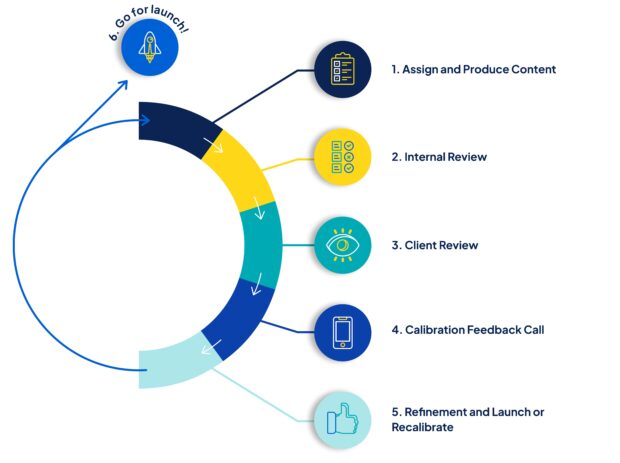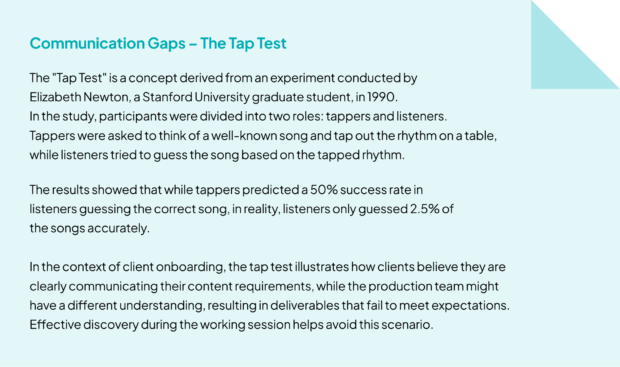
Tips for using the working session deck resource effectively.
TOC:
Download the Working Session Deck
Slide 1: Working Session Title
Slide 2: Meet Your Team
Slide 3: Today’s Topics
Slide 4: Agreement – Key Points
Slide 5: Communication Preferences
Slide 6: Workflow Roles
Slide 7: Turnaround Times
Slide 8: Revisions & Rewrites
Slide 9: Overview of You!
Slide 10: The Content Brief
Slide 11: Voice and Tone Quote
Slide 12: Brand Voice
Slide 13: Style
Slide 14: Content Structure
Slide 15: Optimization
Slide 16: Linking
Slide 17: Calls to Action
Slide 18: Special Requirements
Slide 19: Project Logistics
Slide 20: Workflow Centralization
Slide 21: Calibration Quote
Slide 22: Calibration
Slide 23: Feedback and Touchbases
Slide 24: Communication Quote
Slide 25: What’s Next?
Slide 26: Questions
Slide Guide: Working Session Title Slide
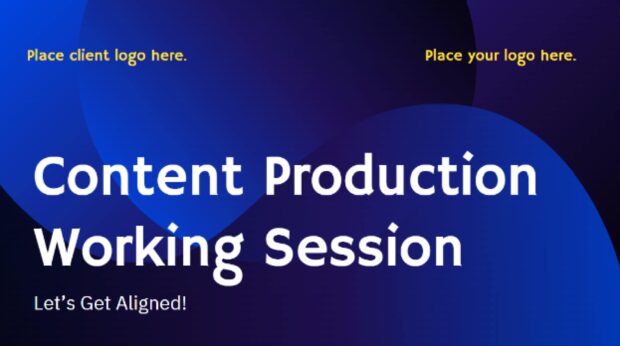
Purpose
Display the client’s and your company logos to set the stage for the working session.
Facilitation Tips
- Who Should Handle This Slide: The session facilitator.
- Time Management: Keep this introduction brief (1-2 minutes).
- Engagement: Use a warm and welcoming voice to set a positive tone for the session.
Updating the Slide
- Add Logos:
- Replace the “Place client logo here” placeholder with the client’s logo.
- Replace the “Place your logo here” placeholder with your company’s logo.
- Ensure the logos are high-resolution and properly aligned.
Discussing the Slide During the Working Session
- Introduction by the Facilitator:
- Briefly welcome everyone and introduce the purpose of the session.
- Establish a protocol for questions. (Recommended: Handle simple questions as they arise; defer questions that will be covered later in the deck.)”
Slide Guide: Meet Your Team
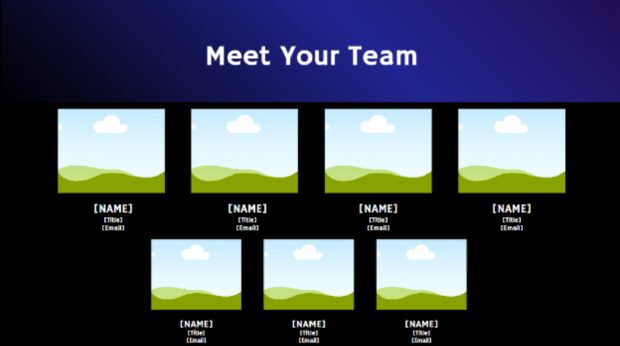
Purpose
Introduce the key members of the project team to the client.
Facilitation Tips
- Who Should Handle This Slide: The session facilitator.
- Time Management: Allocate about 3-5 minutes.
- Engagement: Include a fun fact about each team member to build rapport.
Updating the Slide
- Add Team Member Photos:
- Replace the placeholder images with actual photos.
- Ensure the photos are professional and current.
- Fill in Team Member Details:
- Add each team member’s name, title, and email address.
- Adjust the number of team members displayed as needed.
Discussing the Slide During the Working Session
- Introduction by the Facilitator:
- Invite attending team members to introduce themselves.
- Name and provide a brief description of non-attendees on the slide.
- Team Member Introductions:
- Each team member briefly introduces themselves, mentioning their role in the company, their role in this project, and their background.
- Encourage Client Interaction:
- Ask if the client has any questions about the team.
- Invite the client to introduce themselves.
Slide Guide: Today’s Topics
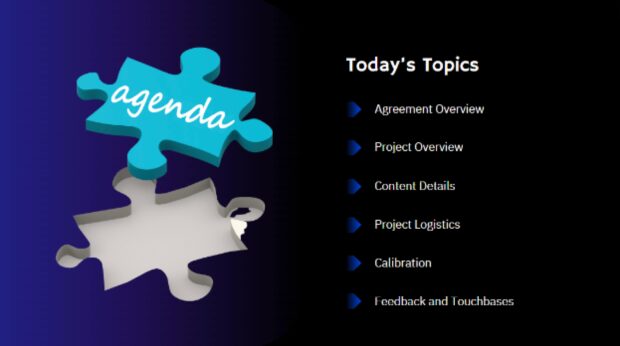
Purpose
Provide an overview of the topics to be covered during the working session.
Facilitation Tips
- Who Should Handle This Slide: The session facilitator.
- Time Management: Keep this section brief (1-2 minutes), but ensure clarity on what will be covered.
- Engagement: Ask the client if there’s anything they’d like to add to the agenda.
Updating the Slide
Review and Adjust Agenda Points:
- Ensure the agenda points match the content and order of the slides in the deck (if you’ve customized it).
- Reword agenda points if necessary to align with specific client needs or terminology.
Discussing the Slide During the Working Session
Introduction by the Facilitator:
- Briefly introduce each topic listed on the slide.
- Explain the flow of the session and the importance of each topic.
Encourage Questions:
- Invite the client to ask any questions about the agenda before proceeding.
Slide Guide: Agreement – Key Points
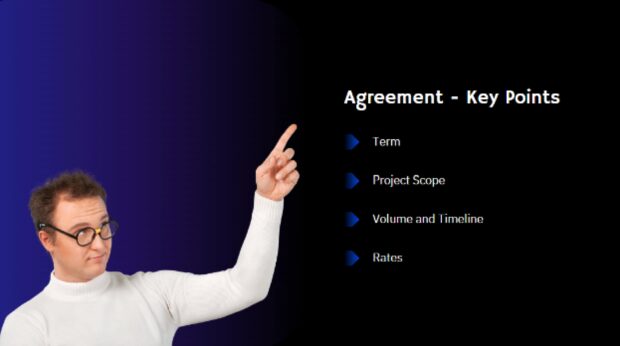
Purpose
Review the high-level points of the agreement to ensure everyone is on the same page regarding the project’s terms, scope, volume, timeline, and rates. It’s important to note that the people at the working session aren’t always the ones who negotiated the agreement. This slide, and several others in the agreement phase, ensure they’re aware of the agreed-upon parameters.
Facilitation Tips
- Who Should Handle This Slide: The session facilitator.
- Time Management: Allocate about 3-5 minutes for this slide to ensure a thorough review without dwelling too long.
- Engagement: Make sure to pause after each key point to allow for questions and ensure understanding.
Updating the Slide
- Adjust Key Points:
- Add or remove key points as needed to reflect the important aspects of your agreement.
Discussing the Slide During the Working Session
- Introduction by the Facilitator:
- Explain that this slide covers the high-level points of the agreement to ensure clarity and alignment.
- Review Key Points:
- Term: Discuss the duration of the agreement.
- Project Scope: Outline the scope of the project, including deliverables and expectations.
- Volume and Timeline: Clarify the volume of content to be produced and the timeline for delivery.
- Rates: Review the agreed-upon rates for the project.
- Encourage Questions:
- Invite the client to ask any questions or seek clarification on any of the points discussed.
Slide Guide: Communication Preferences
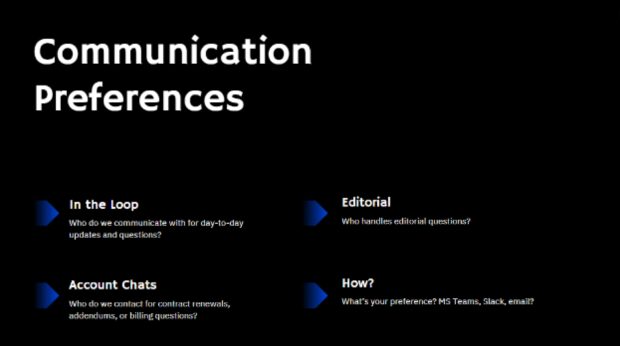
Purpose
Identify the key contacts for various aspects of the project and determine their preferred communication methods.
Facilitation Tips
- Who Should Handle This Slide: The session facilitator.
- Time Management: Allocate about 2-4 minutes to cover this slide thoroughly.
- Engagement: Make sure to record the preferences and contacts discussed to share with the team after the session.
Updating the Slide
- Adjust Roles and Communication Options:
- Update the roles listed (In the Loop, Editorial, Account Management) to reflect those involved in your project.
- Modify the communication options (e.g., MS Teams, Slack, email) to match what you offer.
Discussing the Slide During the Working Session
- Introduction by the Facilitator:
- Explain the importance of clear communication, and introduce the purpose of this slide.
- Identify Key Contacts:
- In the Loop: Discuss who will be the primary contact for day-to-day updates and questions.
- Editorial: Identify who handles editorial questions and decisions.
- Account Chats: Determine who to contact for contract renewals, addendums, or billing questions.
- Determine Communication Preferences:
- Ask each contact about their preferred communication method (e.g., MS Teams, Slack, email).
- Ensure all team members are aware of these preferences to facilitate smooth communication.
Slide Guide: Workflow Roles
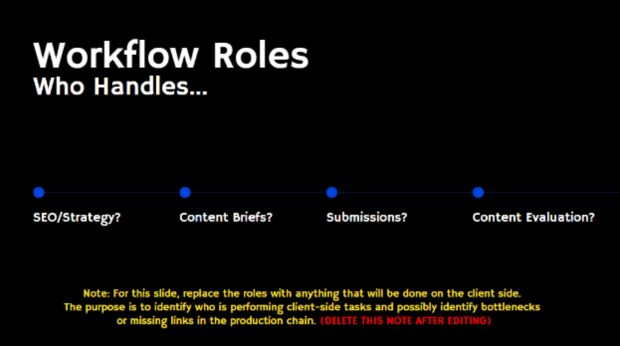
Purpose
Identify the client-side roles responsible for tasks that come before and after the services you provide, ensuring a smooth workflow and identifying potential bottlenecks or gaps in the production chain.
Facilitation Tips
- Who Should Handle This Slide: The session facilitator.
- Time Management: Allocate about 5 minutes to cover this slide thoroughly.
- Engagement: Ensure active participation from the client to accurately map out the workflow roles.
Updating the Slide
- Adjust Roles:
- Replace the listed roles (SEO/Strategy, Content Briefs, Submissions, Content Evaluation) with those relevant to your project.
- Ensure the roles reflect tasks that will be performed on the client side.
Discussing the Slide During the Working Session
- Introduction by the Facilitator:
- Explain that the purpose of this slide is to map out who handles each step in the workflow to ensure clear responsibilities and smooth transitions.
- Identify Client-Side Roles:
- SEO/Strategy: Determine who is responsible for SEO and strategy tasks.
- Content Briefs: Identify who creates the content briefs.
- Submissions: Find out who handles the submission of content.
- Content Evaluation: Clarify who evaluates the content.
- Encourage Questions and Clarifications:
- Ask the client if there are any additional roles or tasks that need to be discussed.
- Identify any potential bottlenecks or gaps in the workflow (for example, clients are often unaware of the time needed to create content briefs, which could lead to submission delays on higher-volume projects).
Slide Guide: Turnaround Times
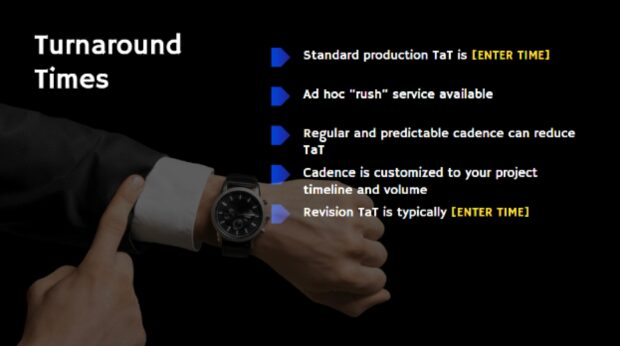
Purpose
Inform the client of standard turnaround times (TaT) to set realistic expectations and avoid unrealistic requests.
Facilitation Tips
- Who Should Handle This Slide: The session facilitator.
- Time Management: Allocate about 2-3 minutes to cover this slide.
- Engagement: Ensure understanding and agreement on turnaround times to prevent future issues.
Updating the Slide
- Enter Standard Turnaround Times:
- Fill in the placeholders for standard production TaT and revision TaT with your specific times.
- Adjust any other points to reflect your actual services and policies.
Discussing the Slide During the Working Session
- Introduction by the Facilitator:
- Explain that this slide covers the standard turnaround times to set clear expectations.
- Review Key Points:
- Standard Production TaT: State the typical time frame for standard content production. Speak in terms of business days from client submission to delivery.
- Ad Hoc “Rush” Service: Mention the availability and conditions for expedited services if you offer them.
- Cadence and Predictability: Emphasize that a regular and predictable cadence can help reduce TaT.
- Customization: Explain that the cadence can be customized to fit the client’s project timeline and volume.
- Revision TaT: Specify the typical turnaround time for revisions.
- For high-volume projects, inform the client that there may be a ramp-up phase before full throughput is achieved.
- Encourage Questions:
- Invite the client to ask any questions or seek clarification on turnaround times.
Slide Guide: Revisions & Rewrites
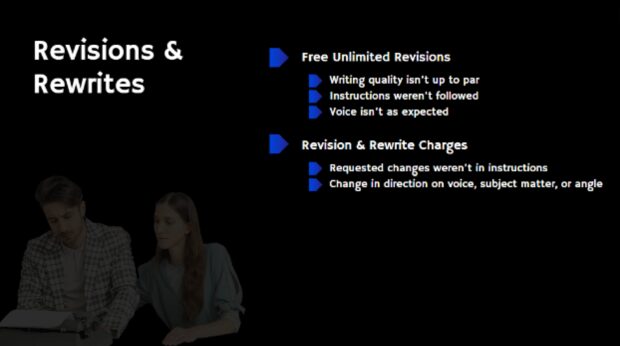
Purpose
Set clear expectations regarding revisions and rewrites to differentiate between free revisions and paid rewrites, ensuring the client understands your policies.
Facilitation Tips
- Who Should Handle This Slide: The session facilitator.
- Time Management: Spend around 5 minutes on this slide to ensure thorough understanding.
- Engagement: Use this opportunity to solidify the client’s understanding and agreement on the policies to prevent future disputes.
Updating the Slide
- Ensure Policy Alignment:
- Confirm that the listed criteria for free revisions and rewrite charges match your internal policies.
- Modify any points to better reflect your specific services and terms.
Discussing the Slide During the Working Session
- Introduction by the Facilitator:
- Begin by explaining the importance of setting clear expectations for revisions and rewrites.
- Highlight the goal of ensuring both parties have a mutual understanding to avoid future misunderstandings.
- Clarify Free Revisions:
- Emphasize that free revisions are intended to address issues like quality, adherence to instructions, and meeting the expected voice.
- Provide examples of what qualifies for a free revision, such as grammatical errors or failure to follow the brief.
- Define Rewrite Charges:
- Explain that rewrites involve significant changes that were not part of the original instructions or involve a change in direction.
- Illustrate with examples, such as a shift in tone or subject matter, that would require additional work beyond a simple revision.
- Encourage Dialogue:
- Ask the client if they have any questions or need further clarification on the differences between revisions and rewrites.
- Invite them to share any concerns or scenarios they foresee, and address those directly.
- Encourage detailed content briefs to ensure the deliverables align with expectations.
Slide Guide: Overview of You!
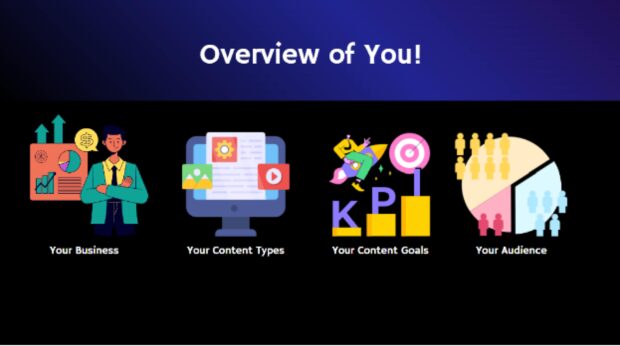
Purpose
Switch the session from the facilitator to the content production manager to gather critical information about the client’s business, content types, goals, and audience. This phase aims to ensure alignment on content production.
Facilitation Tips
- Who Should Handle This Slide: The content production manager.
- Time Management: Allocate about 8-10 minutes to ensure comprehensive coverage of all topics.
- Engagement: Ensure the client is doing most of the talking here, but guide them away from granular content details covered in the following slides.
Updating the Slide
- Note: No need to update this slide unless the information has already been gathered from this same person.
Discussing the Slide During the Working Session
- Introduction by the Content Production Manager:
- Introduce yourself and explain the purpose of this phase: to gather detailed information for content alignment.
- Gathering Information:
- Your Business:
- Ask the client to provide a high-level overview of their business.
- Inquire about their market position and unique selling points.
- Your Content Types:
- Discuss the types of content to be produced.
- Note if there are multiple content types as this phase will need to be repeated for each.
- Your Content Goals:
- Ask about the goals for the content.
- Determine how these goals will be measured (KPIs).
- Your Audience:
- Discover detailed information about the target audience.
- Inquire about documentation or segmentation data.
- Ask about demographics, psychographics, and what resonates with their audience.
- Your Business:
- Encourage Detailed Responses:
- Ensure the client provides thorough information.
- Ask follow-up questions to gain a deeper understanding of each area.
Slide Guide: The Content Brief
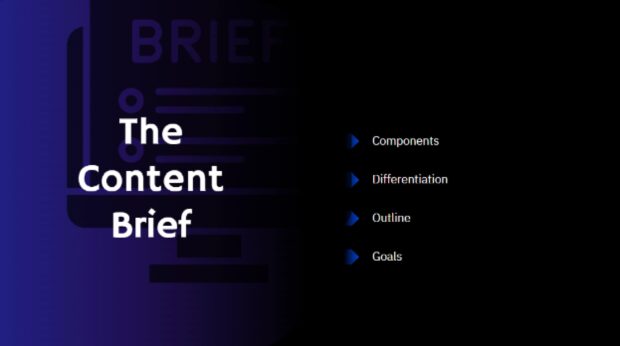
Purpose
Discuss the structure and components of content briefs, whether client-provided or team-developed. Align on what should be included for effective content production.
Facilitation Tips
- Who Should Handle This Slide: The content production manager.
- Time Management: Allocate about 10 minutes for this discussion.
- Engagement: Encourage client interaction to ensure the briefs meet their needs and expectations.
Updating the Slide
- Note: Update the components to reflect any specific elements unique to your content briefs if necessary.
Discussing the Slide During the Working Session
- Introduction by the Content Production Manager:
- Explain that this slide covers key components of the content brief and its importance in content production.
- If Client Provides the Content Briefs:
- Ask About Current Brief Components:
- Inquire about the elements included in their briefs.
- Discuss any challenges or feedback received about their briefs.
- Recommend Additions or Exclusions:
- Suggest improvements, such as removing unnecessary details or adding missing elements.
- Recommend including an outline if not currently provided or removing detailed information better suited for a project brief.
- Ask About Current Brief Components:
- If Your Team Develops the Content Briefs:
- Walk Through the Brief Template:
- Explain each component of your content brief template.
- Ensure the client understands the purpose of each section.
- Highlight Important Review Points:
- Emphasize critical areas for client review when approving briefs.
- Ensure they understand the most useful feedback to provide.
- Walk Through the Brief Template:
- Key Components to Discuss:
- Components: Essential sections of the brief.
- Differentiation: How to ensure the content stands out.
- Outline: The structure or framework of the content.
- Goals: Objectives the content aims to achieve.
Slide Guide: Brand Voice Quote
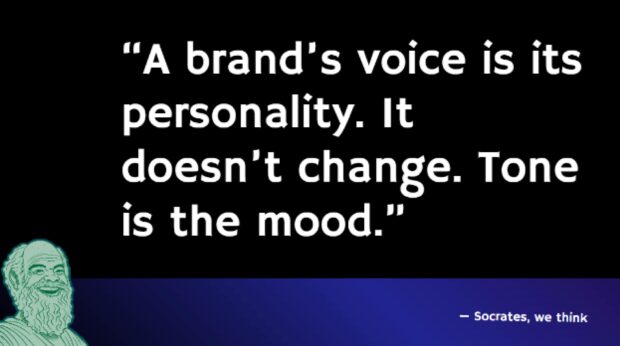
Purpose
Provide a clear distinction between brand voice and tone as a lead-in to the discussion on brand voice.
Facilitation Tips
- Who Should Handle This Slide: The content production manager.
- Time Management: Keep this explanation brief (1 minute) to maintain the flow of the session.
- Engagement: Use this opportunity to ensure the client understands the foundational concepts before moving on.
Updating the Slide
- Note: This slide does not require updates unless the quote needs to be changed.
Discussing the Slide During the Working Session
- Introduction by the Content Production Manager:
- Introduce the concept of brand voice and tone using the quote on the slide.
- Explain why understanding the difference between voice and tone is crucial for consistent and effective content.
- Explain the Difference:
- Brand Voice: Describe brand voice as the consistent personality or character of the brand that remains unchanged across all content.
- Tone: Explain tone as the mood or attitude conveyed in the content, which can vary depending on the context or audience.
- Transition to the Next Slide:
- Indicate that the next slide will go deeper into defining and establishing the brand voice.
Slide Guide: Brand Voice
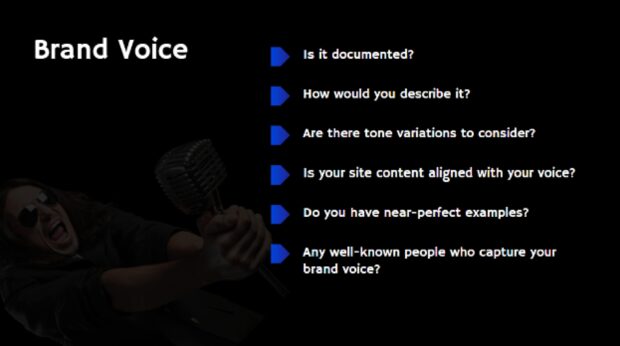
Purpose
Thoroughly understand and document the client’s brand voice to ensure consistent and aligned content production.
Facilitation Tips
- Who Should Handle This Slide: The content production manager.
- Time Management: Allocate about 10 minutes for this discussion.
- Engagement: Actively listen and take detailed notes to inform the content creation process. Steer the client away from vague answers by offering more detailed descriptions.
Updating the Slide
- Note: This slide does not typically require updates unless you have specific brand voice examples to include.
Discussing the Slide During the Working Session
- Introduction by the Content Production Manager:
- Introduce the importance of a clearly defined and documented brand voice for consistent content.
- Determine If Brand Voice Is Documented:
- Ask if the client already has a documented brand voice. If not, emphasize the need for a detailed discovery process.
- Discovery Questions:
- Encourage detailed responses beyond vague descriptors like “authoritative” or “trustworthy.”
- Use examples to help narrow down a more precise description.
- Discuss any variations in tone depending on the context or audience.
- Evaluate if the current content on their site reflects their desired brand voice.
- Ask for examples of content they feel perfectly captures their brand voice.
- Identify if there are celebrities, historical figures, or other brands that embody their voice.
- Inquire if there are other sites or brands they admire and wish to emulate in terms of voice.
- Encourage Detailed Responses:
- Ensure the client provides thorough and actionable information.
- Use follow-up questions to dig deeper and gain a comprehensive understanding.
Slide Guide: Style
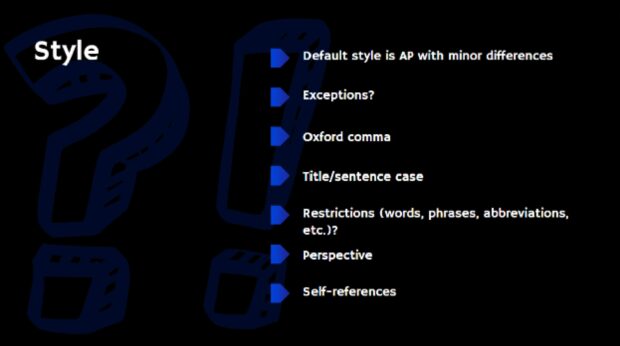
Purpose
Ensure the content aligns with the client’s detailed stylistic preferences for consistency.
Facilitation Tips
- Who Should Handle This Slide: The content production manager.
- Time Management: Allocate about 5-10 minutes to cover this slide thoroughly.
- Engagement: Ask the client for approval on any suggestions you make.
Updating the Slide
- Note: Modify this slide to match your style guide or if AP style is not your default.
Discussing the Slide During the Working Session
- Introduction by the Content Production Manager:
- Confirm the client’s style, grammar, and punctuation preferences upfront.
- Highlight the importance of consistency in decision-making.
- Determine Client Preferences:
- Confirm if AP style is acceptable or if other styles are preferred.
- Inquire about any specific style exceptions or rules.
- Verify preference for using the Oxford comma.
- Confirm if titles should use title or sentence case.
- Discuss restrictions on specific words, phrases, or abbreviations.
- Ask preferred narrative perspective (first, second, or third person).
- Additional Style Considerations:
- Clarify when to spell out numbers versus using numerals.
- Confirm if rhetorical questions are acceptable.
- Ask if advice or opinions should use qualifiers like can, should, and might.
- Discuss usage of common punctuation such as quotation marks
- If a Client Style Guide Exists:
- Acknowledge the existing style guide.
- Only ask about items not covered in their guide.
- Best Practice Suggestions:
- Prepare to offer best practices to clients who are not content experts.
- Provide common stylistic choices that work well in their industry.
Slide Guide: Content Structure
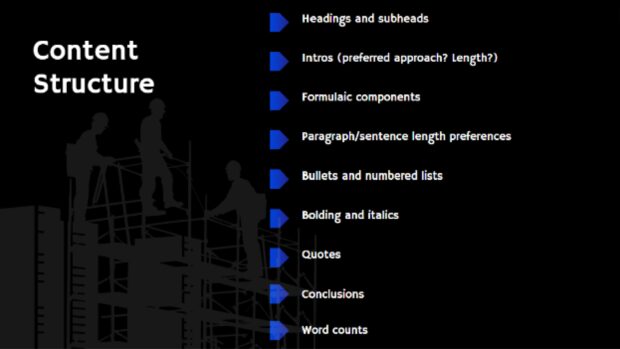
Purpose
Align content formatting and structure with client preferences for consistency.
Facilitation Tips
- Who Should Handle This Slide: The content production manager.
- Time Management: Allocate about 10 minutes to cover this slide thoroughly.
- Engagement: Actively listen and take detailed notes to shape content formatting.
Updating the Slide
- Note: Rarely update this slide unless your content process includes key elements.
Discussing the Slide During the Working Session
- Introduction by the Content Production Manager:
- Explain that this slide covers formatting preferences for consistency.
- Determine Client Preferences:
- Ask about heading and subhead styles (H1s, H2s, etc.).
- Discuss introduction styles, lengths, and formats such as anecdotal, direct, question-based, statistical, or storytelling.
- Identify standard elements required in all content pieces.
- Discuss paragraph and sentence length — shorter and punchier or longer and detailed.
- Ask about bullet points and numbered lists, including lead-ins, punctuation, and length.
- Determine how and when to use bolding and italics for emphasis.
- Discuss the preferred style for incorporating quotes.
- Spend extra time discussing conclusions to understand client preferences for wrapping up content.
- Confirm the desired word count range for different types of content.
- Engage Client in Detailed Discussion:
- Ensure the client provides thorough and actionable direction.
- Be prepared to suggest best practices if the client is noncommittal.
- Use follow-up questions to clarify and dig deeper into their preferences.
Slide Guide: Optimization
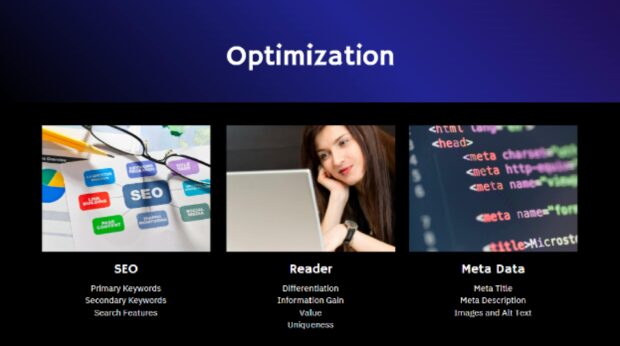
Purpose
Discuss optimization strategies, including SEO, metadata, and reader-focused elements, to ensure content is both search-engine-friendly and valuable to readers.
Facilitation Tips
- Who Should Handle This Slide: The content production manager.
- Time Management: Allocate about 10 minutes for this discussion to ensure thorough coverage of all aspects.
- Engagement: Encourage the client to ask questions and provide input on their optimization preferences.
Updating the Slide
- Note: Update this slide if there are specific optimization techniques unique to your process.
Discussing the Slide During the Working Session
- Introduction by the Content Production Manager:
- Explain that this slide covers various aspects of content optimization, including SEO, metadata, and reader engagement.
- SEO Optimization:
- Discuss the importance of using primary keywords that align with search intent.
- Confirm the client’s primary keywords and how they should be integrated.
- Address the use of secondary keywords for broader reach.
- Talk about optimizing for search features like featured snippets, People Also Ask, and image search.
- Warn against outdated SEO practices, such as keyword stuffing, and recommend modern, effective techniques.
- Reader Optimization:
- Discuss how to make content stand out from competitors.
- Emphasize the importance of providing valuable, unique information that addresses the reader’s needs.
- Highlight the need to deliver high-value content that offers more than just basic information.
- Ensure content is original and offers a fresh perspective.
- Metadata Optimization:
- Discuss the importance of crafting compelling and keyword-rich meta titles. Determine structure and character count.
- Talk about writing engaging meta descriptions that encourage click-throughs. Determine target character count.
- Cover best practices for optimizing images, including using alt text for accessibility and SEO.
Slide Guide: Linking
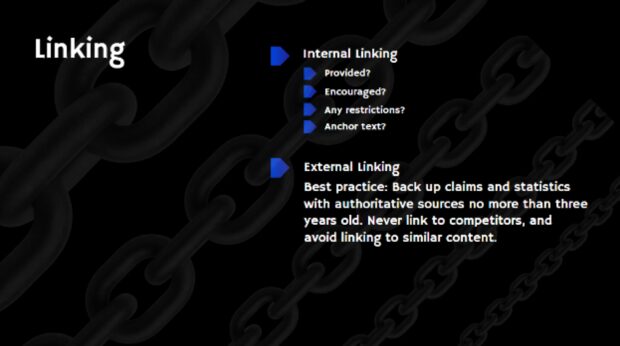
Purpose
Discuss internal and external linking strategies to ensure content is well-supported and search optimized.
Facilitation Tips
- Who Should Handle This Slide: The content production manager.
- Time Management: Allocate about 3-5 minutes for this discussion.
- Engagement: Encourage the client to provide input on their linking preferences and any specific guidelines they have.
Updating the Slide
- Note: This slide does not typically require updates unless there are specific linking practices unique to your process.
Discussing the Slide During the Working Session
- Introduction by the Content Production Manager:
- Explain the importance of both internal and external linking for SEO and content credibility.
- Internal Linking:
- Ask if the client provides specific internal links to be included in the content.
- Determine if the client encourages adding internal links organically.
- Discuss any restrictions on internal linking, such as certain pages that should not be linked.
- Clarify if there are preferences or guidelines for the anchor text used in internal links.
- External Linking:
- Offer to provide the writers with the following guidelines unless the client has specific requests.
- Back up claims and statistics with authoritative sources no more than 3 years old.
- Do not link to competitors (request a competitor list from the client).
- Avoid linking to external content that is too similar to the client’s own content to maintain the unique value of the client’s site.
- Offer to provide the writers with the following guidelines unless the client has specific requests.
Slide Guide: Calls to Action
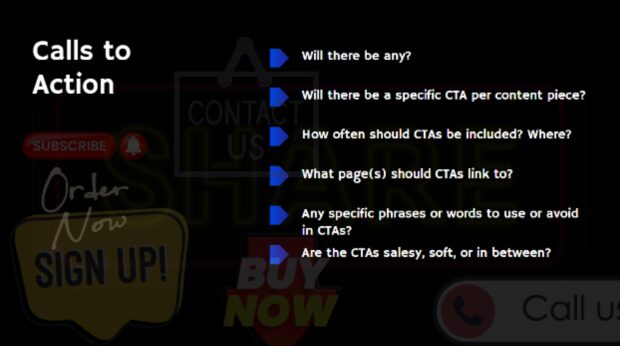
Purpose
Gather detailed information on the client’s preferences for calls to action (CTAs) to ensure they are effective and aligned with the content goals.
Facilitation Tips
- Who Should Handle This Slide: The content production manager.
- Time Management: Allocate about 3-5 minutes for this discussion.
- Engagement: Encourage the client to provide detailed input to ensure CTAs are effective and meet their expectations.
Updating the Slide
- Note: This slide does not typically require updates unless there are specific CTA practices unique to your process.
Discussing the Slide During the Working Session
- Introduction by the Content Production Manager:
- Explain the importance of having clear, specific, and effective CTAs in each piece of content.
- Stress how CTAs drive engagement and conversions, making it crucial to align them with the content’s goals.
- Determine Client Preferences:
- Confirm if the client wants CTAs included in their content.
- Ask if there should be a specific CTA tailored for each content piece.
- Discuss how often CTAs should be included and where they should be placed within the content (e.g., beginning, middle, end).
- Determine which pages the CTAs should link to, ensuring alignment with the client’s conversion goals.
- Identify any specific phrases or words that should be used or avoided in CTAs.
- Ask if the CTAs should be salesy, soft, or somewhere in between.
Slide Guide: Special Requirements
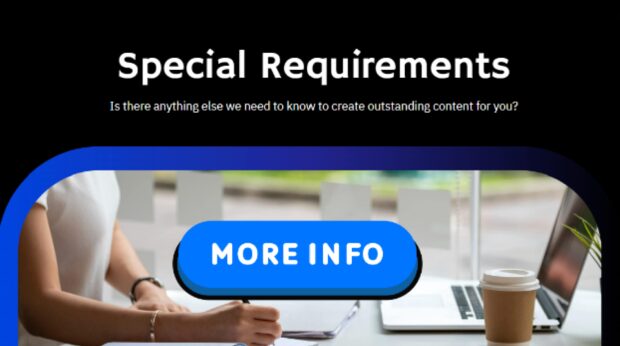
Purpose
Gather any additional information or requirements that have not been covered in previous slides to ensure comprehensive understanding and consistency in content production.
Facilitation Tips
- Who Should Handle This Slide: The content production manager.
- Time Management: Allocate about 3-5 minutes for this discussion to capture any additional details.
- Engagement: Encourage the client to be thorough and provide any last-minute considerations to ensure complete alignment.
Updating the Slide
- Note: This slide does not typically require updates unless there are specific special requirements that are frequently encountered.
Discussing the Slide During the Working Session
- Introduction by the Content Production Manager:
- Explain that this slide is a catch-all for any unique requirements or considerations that have not yet been discussed.
- Encourage Client Input:
- Ask the client if there are any specific requirements or preferences that have not been covered.
- Use context from the session to think of potential questions or areas that might need clarification.
- Possible Areas to Explore:
- Content Type-Specific Needs:
- Discuss any unique elements required for specific content types (e.g., case studies, white papers, social media posts, category descriptions).
- Formatting Preferences:
- Ask if there are any additional formatting guidelines not covered in the content structure slide (tables, infographics, detailed data).
- Language and Localization:
- Discuss any language or localization requirements if the content will be used in different regions.
- Legal and Compliance:
- Identify any legal or compliance considerations that need to be adhered to in the content.
- Brand-Specific Guidelines:
- Check if there are any additional brand guidelines that need to be followed.
- Content Type-Specific Needs:
Slide Guide: Project Logistics
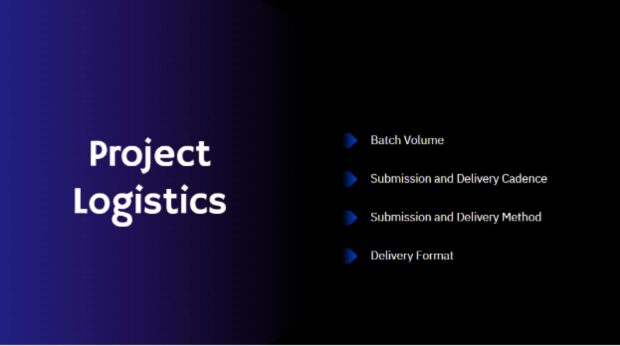
Purpose
Initiate the third phase of the working session, focusing on the logistical aspects of the project to ensure smooth and efficient content production and delivery.
Facilitation Tips
- Who Should Handle This Slide: The content production manager.
- Time Management: Allocate about 5-10 minutes to cover all logistical aspects thoroughly.
- Engagement: Encourage the client to commit to specific submission deadlines to ensure predictable deliveries.
Updating the Slide
- Note: This slide does not typically require updates unless there are specific logistical considerations unique to your process.
Discussing the Slide During the Working Session
- Introduction by the Content Production Manager:
- Explain that this slide will cover the logistical details necessary to manage the project efficiently, focusing on batch volume, cadence, submission, delivery methods, and formats.
- Batch Volume:
- Determine the size of content batches that the client prefers.
- Discuss the advantages of consistent batch sizes for predictable workflow and quality.
- Submission and Delivery Cadence:
- Encourage the client to establish a regular and predictable cadence for submitting content orders.
- Explain how a consistent schedule can lead to better planning and outstanding content production.
- Agree on the frequency of submissions and deliveries (e.g., weekly, biweekly, monthly).
- If possible, set specific submission and delivery deadlines.
- Submission and Delivery Method:
- Discuss how content orders should be submitted (e.g., via email, project management tools, content calendars, content platforms).
- Determine the preferred method for delivering completed content (e.g., content calendar, email, shared drive, content management system).
- Delivery Format:
- Confirm the format in which the content should be delivered (e.g., Word documents, Google Docs, HTML).
- Address any specific formatting requirements or templates the client prefers.
Slide Guide: Workflow Centralization
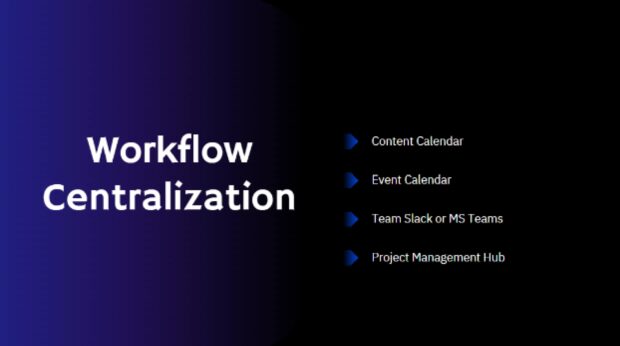
Purpose
Discuss and establish a centralized workflow using various tools to ensure efficient communication, planning, and project management.
Facilitation Tips
- Who Should Handle This Slide: The content production manager.
- Time Management: Allocate about 10 minutes to discuss and finalize the tools and workflow.
- Engagement: Encourage the client to provide input on their preferred tools and ensure all team members are comfortable with the chosen platforms.
Updating the Slide
- Note: This slide may need adjustments depending on the specific tools used by the user and the client.
Discussing the Slide During the Working Session
- Introduction by the Content Production Manager:
- Explain the importance of centralizing workflow to streamline communication, planning, and project management.
- Content Calendar:
- Discuss the use of a content calendar to plan and track content production.
- Confirm the tool that will be used for the content calendar (e.g., Google Sheets).
- Event Calendar:
- Address the need for an event calendar to track important dates, deadlines, and milestones.
- Determine the preferred tool for the event calendar.
- Team Communication:
- Discuss the use of group messaging platforms like Slack or Microsoft Teams for real-time communication and collaboration.
- Establish the primary communication platform and set guidelines for its use.
- Project Management Hub:
- Talk about the project management tools that will be used (e.g., Asana, Basecamp, Trello).
- Confirm the tool that will serve as the central hub for project management.
- Outline how tasks, deadlines, and updates will be managed within the chosen tool.
- Additional Tools and Integration:
- Discuss any other tools that might be useful for the project (e.g., file sharing platforms like Google Drive or Dropbox).
- Address how these tools will be integrated into the overall workflow.
Slide Guide: Calibration Quote
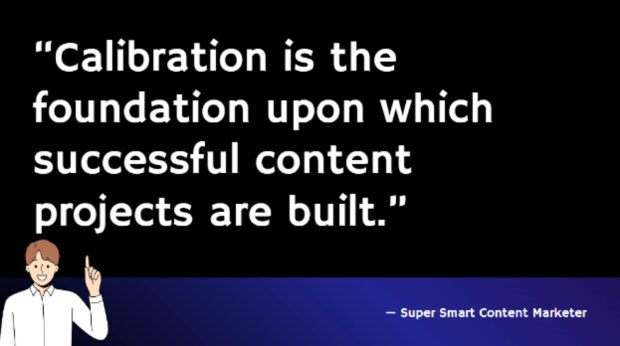
Purpose
Serve as a lead-in to the next slide that discusses calibration. This slide is intended to set the stage for the discussion on calibration, emphasizing its importance in successful content projects.
Facilitation Tips
- Who Should Handle This Slide: The content production manager.
- Time Management: Spend no more than a few seconds on this slide to maintain the flow of the session.
- Engagement: Use this slide to capture the client’s attention and prepare them for the detailed discussion on calibration.
Updating the Slide
- Note: This slide does not typically require updates unless the quote needs to be changed.
Discussing the Slide During the Working Session
- Introduction by the Content Production Manager:
- Briefly introduce the concept of calibration and its critical role in ensuring content projects are successful.
- Use the quote to highlight the foundational importance of calibration in the content creation process.
- Transition to the Next Slide:
- Move quickly to the next slide to dive deeper into the specifics of the calibration process.
- Ensure the client understands that the upcoming discussion will provide detailed information on how calibration will be handled.
Slide Guide: Calibration
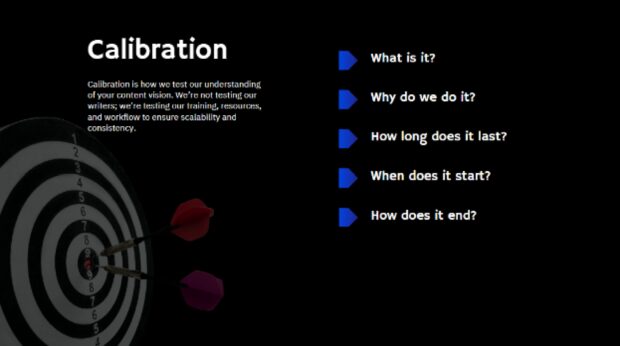
Purpose
Define the calibration process, explain its importance, and establish concrete dates for starting calibration, delivery expectations, and feedback calls.
Facilitation Tips
- Who Should Handle This Slide: The content production manager.
- Time Management: Allocate about 5-7 minutes for this discussion to cover all aspects thoroughly.
- Engagement: Ensure the client understands the calibration process and the importance of their feedback. Encourage active participation in setting dates and providing detailed input. Avoid delaying the setting of dates and times.
Updating the Slide
- Note: This slide does not typically require updates unless the calibration process changes significantly.
Discussing the Slide During the Working Session
- Introduction by the Content Production Manager:
- Define calibration as a process to test the resources and your understanding of the client’s content vision.
- Emphasize that calibration tests the workflow, training, and resources rather than the writers.
- Discuss the Key Questions:
- Explain that calibration is a way to ensure the project resources align with the client’s content vision and goals.
- Discuss the importance of calibration in ensuring scalability and consistency.
- Highlight that it helps identify and address any potential issues early in the project.
- Define the typical duration of the calibration phase.
- Clarify that it involves a few content pieces to start with, to be reviewed and adjusted based on client feedback.
- Establish a start date for the calibration process, typically a few days after the working session.
- Ensure both parties are clear on when the first pieces will be delivered for review.
- Explain that calibration ends once the client approves the initial pieces and both you and the client are satisfied with the alignment.
- Establish Concrete Dates:
- Agree on a specific date to start the calibration process.
- Set clear expectations for when the client will receive the first calibration pieces.
- Schedule a day and time for the calibration feedback call to review the initial content and make necessary adjustments (aim for no more than 4 business days after delivery).
Slide Guide: Feedback and Touchbases
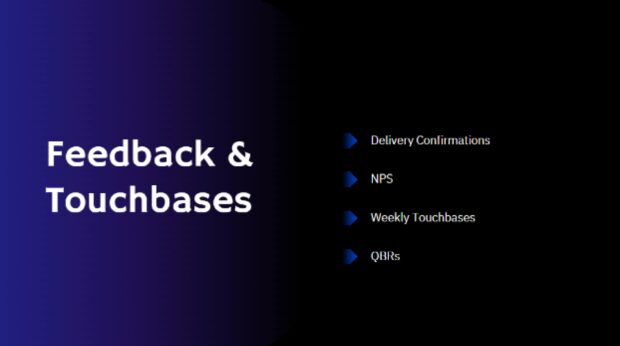
Purpose
Discuss methods for collecting feedback, ensure regular communication, and establish a schedule for touchbases to maintain alignment and address any issues promptly.
Facilitation Tips
- Who Should Handle This Slide: The content production manager or the facilitator.
- Time Management: Allocate about 5 minutes to cover all aspects of feedback and touchbases thoroughly.
- Engagement: Encourage the client to actively participate in setting up the feedback and touchbase schedule and provide input on their preferred methods and frequency of communication.
Updating the Slide
- Note: Adjust this slide to suit your specific feedback methods and communication practices.
Discussing the Slide During the Working Session
- Introduction by the Content Production Manager or Facilitator:
- Explain the importance of regular feedback and touchbases to ensure the project stays on track and meets the client’s expectations.
- Feedback Collection Methods:
- Delivery Confirmations:
- Discuss the process for confirming the receipt of delivered content.
- Ensure the client understands how to provide immediate feedback on each delivery.
- Net Promoter Score (NPS):
- Explain how NPS surveys will be used to gauge client satisfaction.
- Discuss the frequency of these surveys and how the feedback will be used to improve services.
- Delivery Confirmations:
- Regular Touchbases:
- Weekly Touchbases:
- Emphasize the importance of weekly touchbase meetings, especially during the onboarding process.
- Establish a regular day and time for these meetings.
- Clarify the agenda for these touchbases, focusing on progress updates, feedback, and addressing any concerns.
- Quarterly Business Reviews (QBRs):
- Introduce the concept of QBRs to review the overall performance, discuss strategic goals, and plan for the upcoming quarter.
- Schedule the first QBR and discuss the format and objectives.
- Weekly Touchbases:
Slide Guide: Feedback Quote
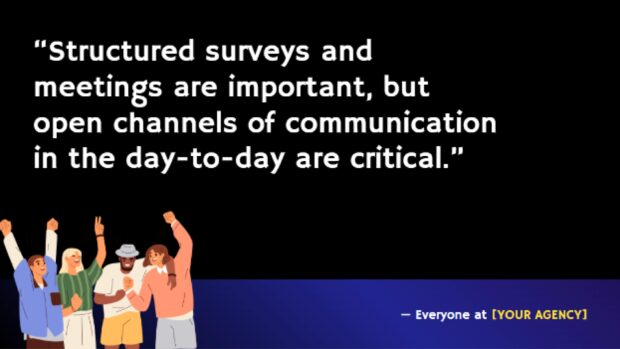
Purpose
Stress the importance of regular feedback and open communication channels to ensure the success of the project.
Facilitation Tips
- Who Should Handle This Slide: The content production manager or the facilitator.
- Time Management: Spend no more than a few seconds on this slide to maintain the flow of the session.
- Engagement: Use this slide to reinforce the importance of feedback.
Updating the Slide
- Note: This slide does not typically require updates unless the quote needs to be changed.
Discussing the Slide During the Working Session
- Introduction by the Content Production Manager or Facilitator:
- Briefly highlight the importance of structured surveys, regular meetings, and open communication channels in the day-to-day operations.
- Emphasize the Key Message:
- Explain that while structured feedback methods (like surveys and scheduled meetings) are essential, open communication channels are equally critical for addressing immediate concerns and ensuring ongoing alignment.
Slide Guide: What’s Next?
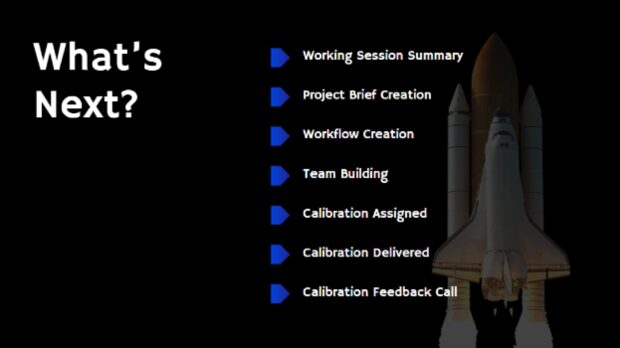
Purpose
Outline the next steps in the process, confirm important dates and times, and ensure all parties are aligned on the upcoming activities.
Facilitation Tips
- Who Should Handle This Slide: The content production manager or the facilitator.
- Time Management: Spend 5 minutes to ensure all next steps are clear and agreed upon.
- Engagement: Encourage the client to ask questions and provide input on the schedule. Ensure mutual understanding and agreement on next steps.
Updating the Slide
- Note: Adjust this slide to reflect any differences in your specific process.
Discussing the Slide During the Working Session
- Introduction: Emphasize the importance of staying on schedule and maintaining communication.
- Outline the Next Steps:
- Working Session Summary:
- Mention a detailed summary will be sent for review and request client approval or feedback.
- Project Brief Creation:
- Explain the process of creating the project brief based on the information gathered during the session.
- Set a deadline for the completion of the project brief.
- Workflow Creation:
- Discuss the creation of the workflow that will guide the content production process.
- Team Building:
- Outline the steps for assembling the content production team.
- Highlight any key roles that will be filled.
- Calibration Assigned:
- Confirm the date when calibration pieces will be assigned to writers.
- Calibration Delivered:
- Confirm the delivery date for the calibration pieces.
- Calibration Feedback Call:
- Confirm the date and time with the client and discuss the agenda for the call.
- Working Session Summary:
- Event Calendar
- Inform the client that agreed dates and times will be added to the event calendar (if used) after the working session summary is approved.
Slide Guide: Questions?

Purpose
Wrap up the working session by providing the client an opportunity to ask any final questions and to ensure that all points discussed are clear.
Facilitation Tips
- Who Should Handle This Slide: The facilitator.
- Time Management: Allow sufficient time for questions and ensure the session doesn’t feel rushed at the end.
- Engagement: Encourage open communication and reassure the client that their input is valuable and appreciated.
- Closing Remarks: End the session on a positive note, ensuring the client feels confident and supported moving forward.
Updating the Slide
- Add Logos:
- Replace the “Place Your Logo Here” placeholder with your company’s logo.
- Optionally, add the client’s logo for a personalized touch.
Discussing the Slide During the Working Session
- Introduction by the Facilitator:
- Summarize the main points discussed during the session.
- Reinforce the importance of the next steps and the agreed-upon timelines.
- Open the Floor for Questions:
- Invite the client to ask any remaining questions or request any clarifications they might need.
- Be prepared to provide detailed answers and additional information as needed.
- Reiterate Availability:
- Let the client know they can reach out after the session if they think of any additional questions or need further assistance.
- Provide contact details if necessary.
- Thank the Client:
- Express appreciation for their time and participation in the working session.
- Highlight the collaborative nature of the partnership moving forward.


